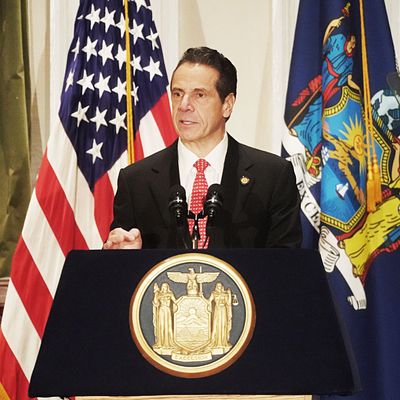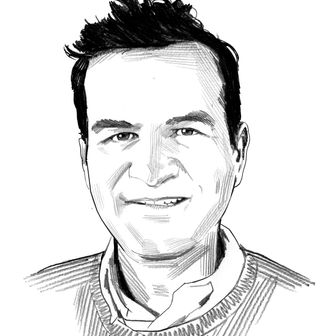
You don’t invoke the name of Franklin Delano Roosevelt, the president who was elected four times, defeated the Nazis, and dragged the country out of the Great Depression because you are trying to invoke in the minds of your audience his three-and-a-half years as governor of New York.
No, you title a speech, “What Would FDR Do Today?” as Andrew Cuomo did Monday afternoon at the New York City Bar Association, because you at least want to fan the flames in the minds of listeners — and the pundit hordes on Twitter — that you are thinking of running for president.
But instead of making any kind of announcement that he was going to be spending Christmas in Iowa, Governor Cuomo used his 45-minute address to pull his signature political move. Capitalizing on the media’s obsession with all things presidential, the governor presented himself as a White House–hungry progressive — a perfect representative of the ideas and appetites animating the Democratic Party right now — and threw a shadow over the arena where the 2020 battle is already playing out.
The speech was a wish list of progressive policy priorities. Among them: legalizing marijuana (something the governor was an avowed skeptic of until recently), a state DREAM Act, congestion pricing to fund the MTA, preserving the millionaire’s tax, more money for schools, a ban on bump stocks, and codifying abortion rights into state law.
“Let this agenda be New York’s Declaration of Independence,” the governor said. “We declare independence from this federal government’s policies. We disconnect from the nationalism, and the racism, and the chaos, and the xenophobia, and the misogyny, and the discrimination, and the dissembling of this Washington administration.” It’s not every day that a (at least historically) moderate governor of a large state delivers a speech that sounds a bit like a secession threat. This declaration, like the original, did not lack for ambitious rhetoric.
Cuomo’s genius as a politician — or, depending on your perspective, his irrepressible Machiavellian nature as a politician — is that he is far less interested in ideology, or proving to activists that he is a fellow traveler, than he is in notching wins. The left in New York will never love Andrew Cuomo, and even as he pledged to pass most of their priorities in the first 100 days of this legislative session, there was grumbling that this pivot was thanks to the spirited campaign challenge he received from Cynthia Nixon in the September primary, a race that Cuomo went on to win in a landslide.
“Some people ask me was it worth it? YES. Here’s why,” Nixon wrote on Twitter above a tweet which bullet pointed many of the priorities the governor laid out.
It is unusual for the governor to make a big speech in December, before his inauguration, before the State of the State, or the annual budget address. Cuomo delivered this one before the new legislature was even seated. This year the state Senate will feature for the first time in 40 years a large Democratic majority, one powered by new lawmakers who were backed by the Working Families Party or by Democratic Socialists of America. These freshmen tossed out a group of moderate Democrats who were aligned with the GOP — a purging of an entrenched Establishment that the governor dismissed the day after the election as just “rearranging the deck chairs.” Still, the new lawmakers, most of whom are new to government, look like a tough group to wrangle; by coming out early with a raft of policy proposals Cuomo is able to look like he was in the right place on the political map all along as the new legislature’s priorities move through Albany.
When Cuomo was first elected in 2010, the tea party was on the rise and the state was climbing out of the Great Recession. He governed as a moderate, capping taxes, taking on the public sector unions, and partnering with Republicans. After 2014, when he was reelected by a large margin and liberals had grown restive, he governed as a liberal, raising the minimum wage, passing paid family leave, and banning fracking.
However, the energy coursing through the state this time isn’t so much left-right as it is reformist; it is about ending Albany’s three-men-in-a-room culture of corruption that has seen both the Republican and Democratic leaders get sent off to prison. It is hard to imagine Cuomo, who cares more about winning than about editorial-board notions like transparency, getting behind such a movement — but on Monday he did anyway, pledging to close the much-reviled LLC loophole that allows the wealthy to skirt the state’s lax campaign-finance laws, and adding that he would work to increase early voting, make Election Day a holiday, and ban lawmakers from receiving outside income.
This isn’t going to convince his critics on left: “His name hasn’t been on one single publicly available email over the past eight years. I mean c’mon,” said Rebecca Katz, a Democratic operative who worked on Nixon’s bid. “If we can’t get a governor who does progressive things because she wants to then I guess we will have to settle for a governor who does progressive things because he has to.” But that was never the point.
Cuomo, even in private, has shown no appetite for mounting a 2020 presidential campaign, people close to him say. Although there isn’t a straight path for the governor to the nomination — not with so many young and liberal and diverse candidates already in the mix — a race with dozens of contenders can break in all sorts of odd ways. (Just look at say, the 2016 Republican race.) As Democrats size up the field, Monday’s speech is a reminder to keep an eye on what the various candidates have already done. Cuomo will enter the 2020 campaign season with a record of accomplishment likely beyond anybody else’s. Whether he will be there in the field, making the case for himself as a declared candidate, is another matter.






























